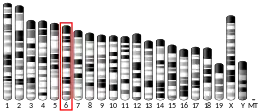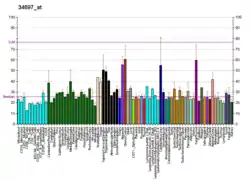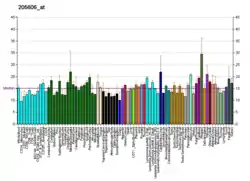Low-density lipoprotein receptor-related protein 6 is a protein that in humans is encoded by the LRP6 gene.[5][6] LRP6 is a key component of the LRP5/LRP6/Frizzled co-receptor group that is involved in canonical Wnt pathway.
Structure
LRP6 is a transmembrane low-density lipoprotein receptor that shares a similar structure with LRP5. In each protein, about 85% of its 1600-amino-acid length is extracellular. Each has four β-propeller motifs at the amino terminal end that alternate with four epidermal growth factor (EGF)-like repeats. Most extracellular ligands bind to LRP5 and LRP6 at the β-propellers. Each protein has a single-pass, 22-amino-acid segment that crosses the cell membrane and a 207-amino-acid segment that is internal to the cell.[7]
Function
LRP6 acts as a co-receptor with LRP5 and the Frizzled protein family members for transducing signals by Wnt proteins through the canonical Wnt pathway.[7]
Interactions
Canonical WNT signals are transduced through Frizzled receptor and LRP5/LRP6 coreceptor to downregulate GSK3beta (GSK3B) activity not depending on Ser-9 phosphorylation.[8] Reduction of canonical Wnt signals upon depletion of LRP5 and LRP6 results in p120-catenin degradation.[9]
LRP6 is regulated by extracellular proteins in the Dickkopf (Dkk) family (like DKK1[10]), sclerostin, R-spondins and members of the cysteine-knot-type protein family.[7]
Clinical significance
Loss-of-function mutations or LRP6 in humans lead to increased plasma LDL and triglycerides, hypertension, diabetes and osteoporosis.[7] Similarly, mice with a loss-of-function Lrp6 mutation have low bone mass.[11] LRP6 is critical in bone's anabolic response to parathyroid hormone (PTH) treatment, whereas LRP5 is not involved.[11] On the other hand, LRP6 does not appear active in mechanotransduction (bone's response to forces), while LRP5 is critical in that role.[11] Sclerostin, one of the inhibitors of LRP6, is a promising osteocyte-specific Wnt antagonist in osteoporosis clinical trials.[12][13]
References
- 1 2 3 ENSG00000281324 GRCh38: Ensembl release 89: ENSG00000070018, ENSG00000281324 - Ensembl, May 2017
- 1 2 3 GRCm38: Ensembl release 89: ENSMUSG00000030201 - Ensembl, May 2017
- ↑ "Human PubMed Reference:". National Center for Biotechnology Information, U.S. National Library of Medicine.
- ↑ "Mouse PubMed Reference:". National Center for Biotechnology Information, U.S. National Library of Medicine.
- ↑ Brown SD, Twells RC, Hey PJ, Cox RD, Levy ER, Soderman AR, Metzker ML, Caskey CT, Todd JA, Hess JF (1998). "Isolation and characterization of LRP6, a novel member of the low density lipoprotein receptor gene family". Biochem. Biophys. Res. Commun. 248 (3): 879–88. doi:10.1006/bbrc.1998.9061. PMID 9704021.
- ↑ "Entrez Gene: LRP6 low density lipoprotein receptor-related protein 6".
- 1 2 3 4 Williams BO, Insogna KL (2009). "Where Wnts went: the exploding field of Lrp5 and Lrp6 signaling in bone". J. Bone Miner. Res. 24 (2): 171–8. doi:10.1359/jbmr.081235. PMC 3276354. PMID 19072724.
- ↑ Katoh M, Katoh M (2006). "Cross-talk of WNT and FGF signaling pathways at GSK3beta to regulate beta-catenin and SNAIL signaling cascades". Cancer Biol. Ther. 5 (9): 1059–64. doi:10.4161/cbt.5.9.3151. PMID 16940750.
- ↑ Hong JY, Park JI, Cho K, Gu D, Ji H, Artandi SE, McCrea PD (2010). "Shared molecular mechanisms regulate multiple catenin proteins: canonical Wnt signals and components modulate p120-catenin isoform-1 and additional p120 subfamily members". J. Cell Sci. 123 (Pt 24): 4351–65. doi:10.1242/jcs.067199. PMC 2995616. PMID 21098636.
- ↑ Semënov MV, Tamai K, Brott BK, Kühl M, Sokol S, He X (2001). "Head inducer Dickkopf-1 is a ligand for Wnt coreceptor LRP6". Curr. Biol. 11 (12): 951–61. doi:10.1016/s0960-9822(01)00290-1. PMID 11448771. S2CID 15702819.
- 1 2 3 Kang KS, Robling AG (2014). "New Insights into Wnt-Lrp5/6-β-Catenin Signaling in Mechanotransduction". Front Endocrinol (Lausanne). 5: 246. doi:10.3389/fendo.2014.00246. PMC 4299511. PMID 25653639.
- ↑ Baron R, Kneissel M (February 2013). "WNT signaling in bone homeostasis and disease: from human mutations to treatments". Nature Medicine. 19 (2): 179–192. doi:10.1038/nm.3074. PMID 23389618. S2CID 19968640.
- ↑ Burgers TA, Williams BO (June 2013). "Regulation of Wnt/beta-catenin signaling within and from osteocytes". Bone. 54 (2): 244–249. doi:10.1016/j.bone.2013.02.022. PMC 3652284. PMID 23470835.
Further reading
- He X, Semenov M, Tamai K, Zeng X (2004). "LDL receptor-related proteins 5 and 6 in Wnt/beta-catenin signaling: arrows point the way". Development. 131 (8): 1663–77. doi:10.1242/dev.01117. PMID 15084453. S2CID 2297859.
- Hillier LD, Lennon G, Becker M, et al. (1997). "Generation and analysis of 280,000 human expressed sequence tags". Genome Res. 6 (9): 807–28. doi:10.1101/gr.6.9.807. PMID 8889549.
- Baens M, Wlodarska I, Corveleyn A, et al. (1999). "A physical, transcript, and deletion map of chromosome region 12p12.3 flanked by ETV6 and CDKN1B: hypermethylation of the LRP6 CpG island in two leukemia patients with hemizygous del(12p)". Genomics. 56 (1): 40–50. doi:10.1006/geno.1998.5685. PMID 10036184.
- Tamai K, Semenov M, Kato Y, et al. (2000). "LDL-receptor-related proteins in Wnt signal transduction". Nature. 407 (6803): 530–5. Bibcode:2000Natur.407..530T. doi:10.1038/35035117. PMID 11029007. S2CID 4400159.
- Mao B, Wu W, Li Y, et al. (2001). "LDL-receptor-related protein 6 is a receptor for Dickkopf proteins". Nature. 411 (6835): 321–5. Bibcode:2001Natur.411..321M. doi:10.1038/35077108. PMID 11357136. S2CID 4323027.
- Semënov MV, Tamai K, Brott BK, et al. (2001). "Head inducer Dickkopf-1 is a ligand for Wnt coreceptor LRP6". Curr. Biol. 11 (12): 951–61. doi:10.1016/S0960-9822(01)00290-1. PMID 11448771. S2CID 15702819.
- Li L, Mao J, Sun L, et al. (2002). "Second cysteine-rich domain of Dickkopf-2 activates canonical Wnt signaling pathway via LRP-6 independently of dishevelled". J. Biol. Chem. 277 (8): 5977–81. doi:10.1074/jbc.M111131200. PMID 11742004.
- Strausberg RL, Feingold EA, Grouse LH, et al. (2003). "Generation and initial analysis of more than 15,000 full-length human and mouse cDNA sequences". Proc. Natl. Acad. Sci. U.S.A. 99 (26): 16899–903. Bibcode:2002PNAS...9916899M. doi:10.1073/pnas.242603899. PMC 139241. PMID 12477932.
- Caricasole A, Ferraro T, Iacovelli L, et al. (2003). "Functional characterization of WNT7A signaling in PC12 cells: interaction with A FZD5 x LRP6 receptor complex and modulation by Dickkopf proteins". J. Biol. Chem. 278 (39): 37024–31. doi:10.1074/jbc.M300191200. PMID 12857724.
- Liu G, Bafico A, Harris VK, Aaronson SA (2003). "A novel mechanism for Wnt activation of canonical signaling through the LRP6 receptor". Mol. Cell. Biol. 23 (16): 5825–35. doi:10.1128/MCB.23.16.5825-5835.2003. PMC 166321. PMID 12897152.
- Zilberberg A, Yaniv A, Gazit A (2004). "The low density lipoprotein receptor-1, LRP1, interacts with the human frizzled-1 (HFz1) and down-regulates the canonical Wnt signaling pathway". J. Biol. Chem. 279 (17): 17535–42. doi:10.1074/jbc.M311292200. PMID 14739301.
- Wang X, Adhikari N, Li Q, Hall JL (2005). "LDL receptor-related protein LRP6 regulates proliferation and survival through the Wnt cascade in vascular smooth muscle cells". Am. J. Physiol. Heart Circ. Physiol. 287 (6): H2376–83. doi:10.1152/ajpheart.01173.2003. PMID 15271658.
- Suzuki Y, Yamashita R, Shirota M, et al. (2004). "Sequence comparison of human and mouse genes reveals a homologous block structure in the promoter regions". Genome Res. 14 (9): 1711–8. doi:10.1101/gr.2435604. PMC 515316. PMID 15342556.
- Gerhard DS, Wagner L, Feingold EA, et al. (2004). "The status, quality, and expansion of the NIH full-length cDNA project: the Mammalian Gene Collection (MGC)". Genome Res. 14 (10B): 2121–7. doi:10.1101/gr.2596504. PMC 528928. PMID 15489334.
- Li Y, Lu W, He X, et al. (2005). "LRP6 expression promotes cancer cell proliferation and tumorigenesis by altering beta-catenin subcellular distribution". Oncogene. 23 (56): 9129–35. doi:10.1038/sj.onc.1208123. PMID 15516984. S2CID 11159925.
- Semënov M, Tamai K, He X (2005). "SOST is a ligand for LRP5/LRP6 and a Wnt signaling inhibitor". J. Biol. Chem. 280 (29): 26770–5. doi:10.1074/jbc.M504308200. PMID 15908424.
- Li Y, Chen J, Lu W, et al. (2006). "Mesd binds to mature LDL-receptor-related protein-6 and antagonizes ligand binding". J. Cell Sci. 118 (Pt 22): 5305–14. doi:10.1242/jcs.02651. PMID 16263759.
- Mi K, Dolan PJ, Johnson GV (2006). "The low density lipoprotein receptor-related protein 6 interacts with glycogen synthase kinase 3 and attenuates activity". J. Biol. Chem. 281 (8): 4787–94. doi:10.1074/jbc.M508657200. PMID 16365045.






